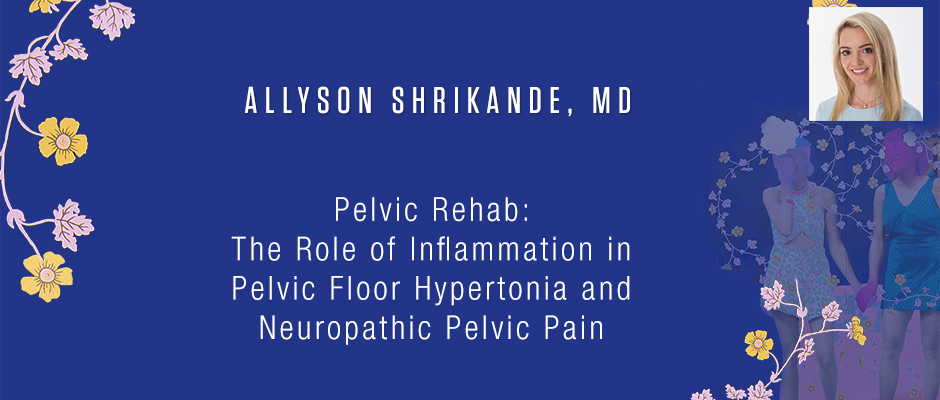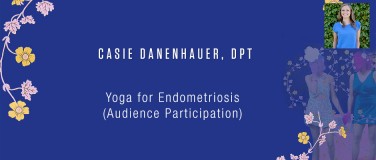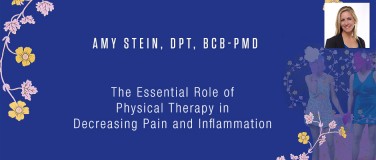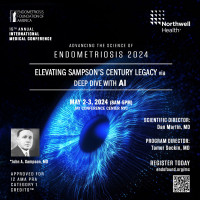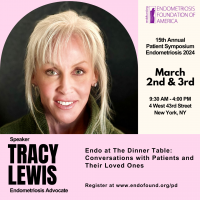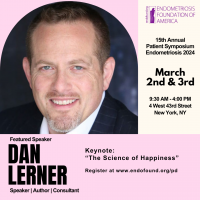Allyson Shrikande, MD - Pelvic Rehab: The Role of Inflammation in Pelvic Floor Hypertonia and Neuropathic Pelvic Pain
Patient Awareness Day 2019: HEALTHY MIND & HAPPY PELVIS
Living Your Best Life With Endo
March 10, 2019 (8am - 5pm)
Einhorn Auditorium, Lenox Hill Hospital, New York City
https://www.endofound.org/patientday/2019
Good afternoon. Thank you, Dr. [Seckin 00:00:16] and Dr. Lau and Dr. Goldstein and the EFA for hosting this wonderful conference. I'm very excited to be here. I'm talking about how inflammation affects the muscles and nerves and chronic pelvic pain. No disclosures.
Objectives. The physiatrist approach to endometriosis, a little bit about neurogenic inflammation. Then I was asked to speak about an emerging therapy in regenerative medicine that we're doing.
The physiatrist approach to pelvic pain. First of all, what is a physiatrist? If you don't know, that's okay. I think my parents are still trying to figure out what I do. But really what we are is we're bringing the orthopedic and neurology approach to pelvic pain and correlating it with the gynecologists. We treat the muscles, the nerves, and the joints of the pelvis.
The symptoms that we see and treat, we like to describe to our patients. The pelvic floor is a sling of muscles. It goes from the pubic symphysis in the front to the coccyx or tailbone in the back.
Endometriosis itself, looking at the anatomy picture here, is found in and out throughout the credits that are seen. With this, there can be some chronic guarding in the pelvic floor musculature, which we call muscle spasm or pelvic floor hypertonia, which also can correlate with some nerve pain or neurogenic inflammation.
As my daughter says, we like to talk about pee and poop all day, but we really do. We ask patients, how is their bladder? Are you peeing a lot? Do you have urgency, frequency, and burning with urination? We talk a lot about bowels. We say constipation is the enemy of the pelvic floor. A lot of what we're doing is trying to prevent constipation and we focus on any pain with bowel movements and straining.
Then, of course, intercourse. We talk a lot about pain with intercourse. Is it superficial, deep, positional? As Dr. Sesskin had alluded to, it's one of the most common things we see is actually pain post intercourse.
As physiatrists, we're really into functions or we're all about a return to function. What we're studying is the improvement in what we call the functional pelvic pain scale. So again, looking at the bladder or bowel, intercourse, exercise, and with prolonged sitting with working.
This is the anatomy. This is the world we live in and when we're evaluating patients we do a typical musculoskeletal physiatry exam where we have patients stand up. We analyze their gait. Are they pronating? Any [inaudible 00:03:02] weakness, et cetera. But we're also looking at their hips, their abdomen for any diastasis recti, concern for any hernias. But we do an internal exam, which is a unique aspect of what we do, looking at both the muscles and the nerves internally.
This is a picture of how muscles contract and with the spastic muscle they are short, spastic, and weak and there's a loss of that each zone.
This picture is courtesy of Dr. Hill who's in the audience. This is the cycle that we see and treat. Essentially with this chronic guarding state, when patients are in pain and in addition to endometriosis being in this pro-inflammatory state, the muscles do go into this chronic guarding state.
At that point, you get decreased circulation in the local environment and that leads to a local decrease in blood flow and a change in the PH which stimulates this whole inflammatory cascade. In addition, you get some compensatory mechanisms that can happen in the surrounding joints and lumbosacral spine.
This is a picture of the inflammatory soup that we like to talk about, these pro-inflammatory cytokines that hang out all along the peripheral nerves and this is what we try to get rid of essentially.
The pathophysiology of chronic pelvic pain, so experiencing pain for long periods of time, which can happen with endometriosis particularly because there can be, as we have mentioned throughout this conference, a delayed diagnosis. When you do experience pain for long periods of time, there are actually changes in how your brain perceives and processes pain signals. This is what leads to this amplification of pain and what you'll hear alluded to as central sensitization.
That's why it is important for practitioners to really be aware of endo and try and guide their patients to a proper excision surgery and then you can tweet them afterward if needed.
The treatment algorithm for chronic pelvic pain, particularly patients who we see post excision surgery, we start with pelvic floor physical therapy, a course of that which was just described beautifully by Dr. Stein, and follow up after that. It's usually two, three months of physical therapy.
We created a protocol where patients who plateaued in physical therapy, essentially do external ultrasound-guided trigger point injections to the levator ani sling in combination with hydro dissection peripheral nerve blocks. We also do use some medications for certain patients, particularly CNS neuromodulators to really help treat the central sensitization and essentially calm down the nervous system.
To Dr. [inaudible 00:05:59] question, we do use volume suppositories as well. Sometimes they are not, they're almost more diagnostic than therapeutic. I find that patients do respond if the volume suppositories for one month helps, then they respond well to our protocol because it's not a long-term solution. Also, it's not a quick fix. It's just a small part of the treatment protocol, but they can help take the edge off.
The pathophysiology of the protocol that we do. Essentially, we're treating the altered response of the sodium channels on these primary afferent nerve fibers with this repeated anesthetic exposure. We're addressing the connective tissue bands that surround the nerves and we're depleting the substance P histamine and other pro-inflammatory neuropeptides that comprise this inflammatory soup that we talk about.
These are just some images of the ultrasound that we do. This is what I was asked to focus on. This is a technique in the realm of regenerative medicine and it's called Alpha Two macroglobulin. What it is, it's a protease inhibitor and so inactivates a variety of protein A's. It inhibits fibrinolysis lysis and inhibits coagulation. It's used in chronic pain because what it does is decrease inflammation.
Essentially it's a carrier protein that binds to these growth factors and pro-inflammatory cytokines and takes them out of your body. I have a picture of a Pac-Man here because when talking to the patients, that's how we describe it. It's like a little Pac-Man. It eats up that inflammatory soup and it takes it out of your body.
There are minimal data on it. Most of the data is really done at this point in rats and what they're looking at as a chondroprotective agent for osteoarthritis of the knee. It's been shown to decrease the degradation of the cartilage.
The trial that we have done, it's an IRB-approved trial. It's a retrospective trial with 11 patients. Seven of them are male and four are female. The ages are 31 to 59. Four of the patients had a pathology of endometriosis, so they had excision surgery and were diagnosed with endometriosis, and six of the patients had an additional diagnosis of interstitial cystitis.
What we did was analyzed the VAS scale for pain, as well, the visual analog scale as well as the functional pelvic pain scale, which we talked about earlier, pre and post-treatment. We did it at the 12 weeks follow-up. All of these patients had had the excision surgery if they had endo and had completed a course of pelvic floor physical therapy.
Honestly, these patients were really at their wit's end. It was really debating, do you want to try some regenerative medicine or a pudendal nerve surgical release or a neurostimulator at that point. Over 50% of the patients had tried already radiofrequency ablation of the penal nerve as well as ganglion impar blocks and hypogastric blocks. It was definitely our most challenging patient that we used this on.
How it works. So 90 milliliters of the patient's blood was drawn and centrifuged. You can see the picture of it on the top. The A2M concentrate was isolated and then injected under ultrasound guidance externally along with the levator ani muscles and the pudendal nerve and its branches.
This is the data. The functional pelvic pain scale went from 13 down to 5.8 and the VAS scale went from 5.8 down to 3.6 posts. Interestingly enough, the most improvement was shown in the bowel, intercourse, walking, sleeping, prolonged sitting, and lifting.
This study has promising results in regards to using alpha two as a novel regenerative non-opioid treatment for patients with chronic pelvic pain. It provides a foundation but clearly, we need further research with much larger sample sizes and longer follow-up.
We talk a lot about a healthy lifestyle with our patients. We focus a lot on nutrition, exercise, as Amy Stein had referred to. We do like to keep our patients moving, so it is important to look at the whole patient and really go through lifestyle.
These are our favorite yoga poses, which we'll go into more detail in another session, but restorative poses that really focus on keeping the pelvis open, creating space, and increasing blood flow, and down-regulating your nervous system via the vagus nerve.
I'll leave with this. This really shows the importance of a multimodal approach to patients with endometriosis and as practitioners, we really do think about treating the entire patient, focusing on their immune system, HPA access, as well as the central and peripheral nervous system.
Thank you very much.



